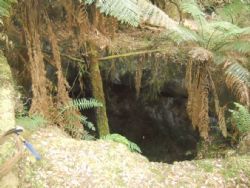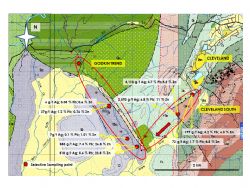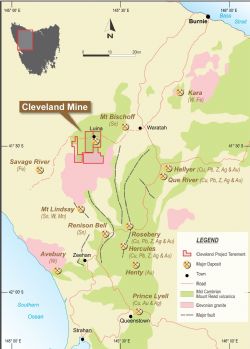
High Grade Silver-Lead-Zinc Identified South of the Cleveland Tin Project
Brisbane, Mar 7, 2014 AEST (ABN Newswire) - Elementos Limited ( ASX:ELT) ("Elementos" or the "Company") is pleased to announce the results of its first sampling program at the Godkin and Cleveland South Zones, two kilometres south of the Cleveland tin mine.
ASX:ELT) ("Elementos" or the "Company") is pleased to announce the results of its first sampling program at the Godkin and Cleveland South Zones, two kilometres south of the Cleveland tin mine.
An initial selective sampling program over the prospective zones produced results including:
Godkin - five selective samples were taken from mullock dumps including:
- 553 g/t silver, 7.4% lead and 26.5% zinc; and
- 518 g/t silver, 5.6% lead and 22.5% zinc.
Cleveland South - six selective samples were taken from mullock dumps at the South Confidence and Washington Hay historic workings including:
- 4,110 g/t silver, 4.7% lead, 5.28% zinc; and
- 2,570 g/t silver, 6.8% lead and 11.0% zinc.
A trial soil sampling program has commenced at Godkin and Cleveland South, to define the structures that host the mineralisation. The focus of on-going exploration is to delineate potential mineralised areas for drill targeting purposes.
North-west Tasmania is a world-class minerals district and host to significant historical lead-zinc-silver mines including Hellyer, Roseby and Que River (Figure 4). These deposits are situated within 40 kilometres of the Cleveland tenements, with Elementos controlling 96km2 of prospective tenements in the district that have undergone limited modern day exploration.
The Company's priority focus is the development of the Cleveland tin project. However, the new zones add an extra dimension to the Company's tenement portfolio in the district. In the short-term, the Company will continue to undertake low-cost exploration activities to build a detailed understanding of the geological potential of the district.
Godkin Zone
The Godkin silver-lead-zinc zone, located two kilometres south-east of the Cleveland tin mine, includes a number of small underground mines scattered over two kilometres along a north-west striking structural trend. The zone includes Godkin South, Godkin Extended, Bells Reward and Whyte River historic workings, which are all subject to small-scale underground production from the late 1800´s to the early 1900´s. There is now little evidence of the old workings (mostly adits and small shafts) or outcropping rock, as vegetation and soils are the dominant features.
The highest silver-lead-zinc grades come from selective samples at Godkin South. The high-grades are related to a brecciated silicified limestone with massive galena and sphalerite matrix and veinlets (Figure 1 in link below).
The geological environment in the Godkin Zone is encouraging as there is a north-west trending belt of limestones in contact with sandstone, all intruded by small granite stocks, amenable for carbonate replacement style of mineralisation. Carbonate replacement mineralisation tends to generate larger mineralised bodies which could carry high-grade silver-lead-zinc deposits, as found in sampling in the mineralised limestones at the Godkin South workings, where karst topography could be recognised on the surface around the remnants of the old workings (Figure 2).
The other historic workings in the Godkin Zone are in the vicinity of a limestone belt and granite stocks. Three selective samples from gossan material within the Godkin Zone returned anomalous silver-lead-zinc assays including 27 g/t silver, 1.2% lead and 0.759% zinc.
Cleveland South Zone
In the Cleveland South Zone two small underground mines, Washington Hay and Confidence, which are located 200 metres south-east and 600 metres south-east of the Cleveland tin mine respectively, were recognised and selectively sampled. High grade silver-lead-zinc mineralisation at the Confidence workings is related to strongly silicified sandstone with massive galena-sphalerite veinlets and matrix fill. Material that was not obviously mineralised was also sampled and returned anomalous values on the same metals (See Table 1 in link below).
Silver-Lead-Zinc Prospectivity of the District
Reconnaissance geology and sampling, in conjunction with the interpretation of the regional scale ground magnetic survey, highlights the potential for the north-west Godkin trend to merge with the north-east Cleveland South trend (Figure 3). This area will be a particular focus of future exploration.
Future Exploration Activities
Reconnaissance work conducted at Godkin and Cleveland South Zones suggests there is potential for lead-zinc-silver mineralisation. The area has only been subject to small-scale selective mining and limited modern exploration. Future exploration activities will include:
- Detailed soil sampling and mapping at the Godkin and Cleveland South Zones. A trial soil sampling survey is underway at Godkin South workings to assist in understanding the structural hosts of the mineralisation;
- Pole-Dipole Induced Polarisation and gravity surveys targeting deeper mineralised structures. Historically, zinc was not a commodity targeted when the mines were active and the Company believes there is potential for high-grade zinc lenses in the underground works; and
- Define drill targets through the sampling, mapping and geophysics.
Calvin Treacy, Managing Director said "We are very excited to have identified new mineralisation within the Cleveland exploration leases. The new zones of mineralisation are situated in areas prospective for carbonate style mineralisation and within 40 kilometres of major lead-zinc-silver deposits including Hellyer, Que River and Roseby".
To view tables and figures, please visit:
http://media.abnnewswire.net/media/en/docs/76726-ASX-ELT-787056.pdf
Contact
Calvin Treacy
Managing Director
Phone: +61-7-3221-7770
Email: admin@elementos.com.au
| ||
|









